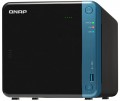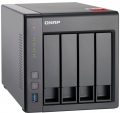PCI-E
The number of
PCI-E slots provided in the design of the NAS server.
PCI-E is one of the most popular modern interfaces for connecting internal components to a computer motherboard. Specifically, in NAS servers, it can be used, in particular, for wireless adapters and SSD drives; in the latter case, PCI-E allows higher speeds than SATA and fully realizes the potential of solid-state memory. And the number of such connectors corresponds to the number of PCI-E components that can be simultaneously installed in the server.
Note that the PCI-E connection can use a different number of lines (1x, 4x, 16x), and for normal operation it is necessary that the slot on the "motherboard" has no fewer lines than the installed component. In fact, this means that a component with a 1x connector will easily fit into any slot, but with a larger connector, the connection should be specified separately. However, in the case of NAS servers, even PCI-E 4x capabilities are rarely required, not to mention 16x.
USB 2.0
The number of
USB 2.0 ports provided in the design of the NAS server.
USB connectors are used in computer technology to connect various external peripherals. In the case of NAS servers, we are most often talking about external drives — flash drives, hard drives, etc. In this way, you can transfer information from an internal drive to an external one (for example, for backup purposes) or vice versa, and even expand the total working volume of the server . In addition, on models with a VGA output (see below), a keyboard can also be connected to USB, and on models with a print server function (see "Software Features"), respectively, a printer. For added convenience, the USB connector can be placed on the front panel (see below).
As for USB 2.0 specifically, today this version is generally considered obsolete due to the relatively low speed (up to 480 Mbps) and the low power supplied through the connector. Peripherals of newer versions can be connected to such a port, however, the speed will be limited by the capabilities of version 2.0, and the power supply may not be sufficient. Therefore, in modern NAS servers, such connectors are quite rare — mainly as an addition to the newer and faster USB 3.2 gen1 (see below), designed for relatively unpretentious peripherals like keyboards.
USB 3.2 gen1
The number of
USB 3.2 gen1 ports provided in the design of the NAS server.
USB connectors are used in computer technology to connect various external peripherals. In the case of NAS servers, we are most often talking about external drives — flash drives, hard drives, etc. In this way, you can transfer information from an internal drive to an external one (for example, for backup purposes) or vice versa, and even expand the total working volume of the server . In addition, on models with a VGA output (see below), a keyboard can also be connected to USB, and on models with a print server function (see "Software Features"), respectively, a printer. For added convenience, the USB connector can be placed on the front panel (see below).
Specifically, USB 3.2 gen1 (formerly known as USB 3.0 and USB 3.1 gen1) is the direct successor to USB 2.0 and is the most common USB standard today. This version provides data transfer rates up to 4.8 Gbps, as well as a fairly high power supply. At the same time, such connectors are backward compatible with peripherals using USB 2.0.
HDMI
The presence of an
HDMI output in the NAS server; either the presence of such a connector itself or its specific version can be indicated here.
HDMI is a digital interface specifically designed to carry high-definition video and multi-channel audio. This is the most common of these interfaces, most modern monitors, TVs, home theaters, projectors, etc. have this type of input. Thus, even in such a specific technique as NAS servers, such outputs have several applications. The first option is to connect a monitor to monitor the parameters of the server; some devices at the same time allow you to connect keyboards / mice and control the server directly, like a regular computer. The second option is to use the NAS server as a media centre to broadcast movies and other content to a TV, home theater, etc.
The specific functionality of HDMI should be specified separately. As for the versions, the following options are relevant today:
— v 1.4. Relatively old (2009), but still quite widely used version. Supports resolutions up to 4096x2160 (at 24 fps), as well as frame rates up to 120 Hz, which allows you to play 3D content as well. It is found both in the original version and in improved versions v 1.4a and v 1.4b — they have advanced features for working with 3D.
-v 2.0. Version released in 2013. The increased bandwidth compared to its predecessor made it possible to provide full support for 4K video (at frame
...rates up to 60 Hz), as well as multi-channel audio up to 32 channels and 4 streams over a single cable. HDMI v 2.0 did not originally support HDR, however this feature was introduced in the v 2.0a update and was improved and expanded in v 2.0b. With all this, old cables, originally designed for version 1.4, are also suitable for connecting according to this standard.
— v 2.1. Standard introduced in 2017. Also known as HDMI Ultra High Speed, bandwidth has increased so much that it is possible to transmit video at resolutions up to 10K at 120 frames per second. Note that to use all the features of this version, you need cables that were originally created for it (although the functionality of earlier versions will be available when connected via a regular cable).
In conclusion, we note that different versions of HDMI are mutually compatible, however, the signal transmission capabilities in such cases will be limited by the characteristics of the older and slower standard.CPU
The model and specifications of the processor installed in the NAS server. The speed of the device largely depends on these characteristics, primarily the clock frequency. However, in fact, this parameter is often more of a reference value: simple everyday tasks (say, FTP and print servers, see "Software Features") do not require high computing power. But for working with extensive databases (see ibid.), a “faster” processor may be useful.
CPU speed
Clock speed of the processor installed in the NAS server.
The clock frequency is the frequency of the built-in oscillator, according to which all operations performed by the processor are synchronized. The higher this frequency, the more operations per second the CPU can perform and the easier it is to provide high computing power in it. However, note that the actual speed of the processor depends on many other features — the number of cores (see above), microarchitecture, volumes of the built-in cache memory, etc. So, only chips with similar characteristics and purpose can be directly compared by clock frequency ( desktop/mobile) and price category.
TurboBoost frequency
Processor clock speed achieved in TurboBoost or TurboCore "overclocking" mode.
Turbo Boost and Turbo Core technologies are used by different manufacturers (Intel and AMD, respectively), but they have the same principle of operation: load distribution from more loaded processor cores to less loaded ones to improve performance. The "overclocking" mode is characterized by an increased clock frequency, and it is indicated in this case.
For more information about clock speed in general, see the relevant paragraph above.
Power consumption
The amount of power consumed by the NAS server during normal operation. Most often, we are talking about maximum power consumption — with all the occupied slots for drives, under high load.
Modern NAS, even high-performance ones, have rather modest power consumption — even among professional models with 10 or more drives, this figure rarely exceeds 1 kW. So there are no problems with connecting to a 230 V network. However, energy consumption information can be useful for some special applications, primarily for estimating the load on UPSs, emergency generators, stabilizers, and other special equipment.
Remote control
A remote control is included with the NAS server.
When using the device for its main purpose, as a server itself, the remote control is not required. Therefore, this function is found only in models with advanced multimedia capabilities — DLNA, iTunes, video surveillance server, etc. (see "Software Features") — as well as at least one video output, most often HDMI (see above). The convenience of the remote control is obvious: it allows you to give commands (for example, to control the built-in player), without approaching the device for this.

